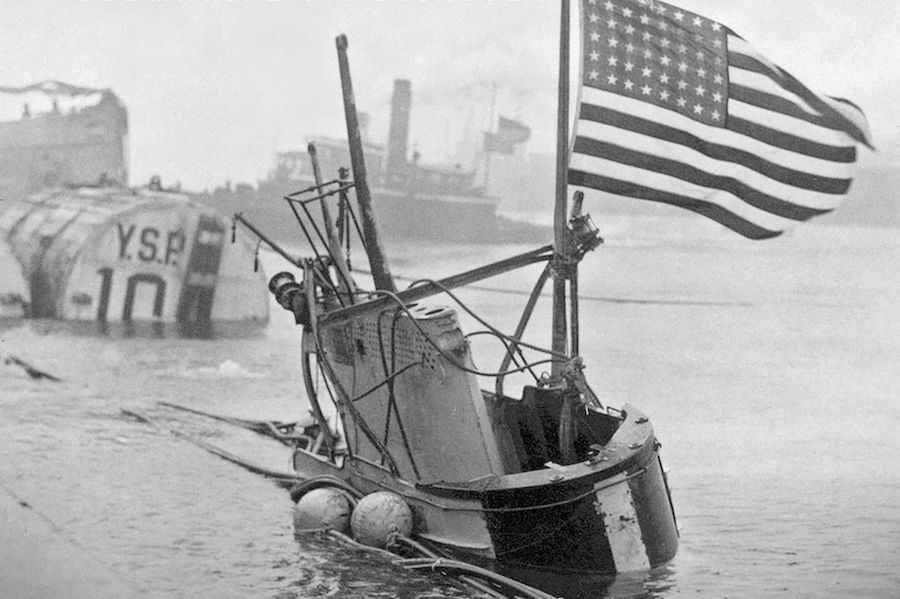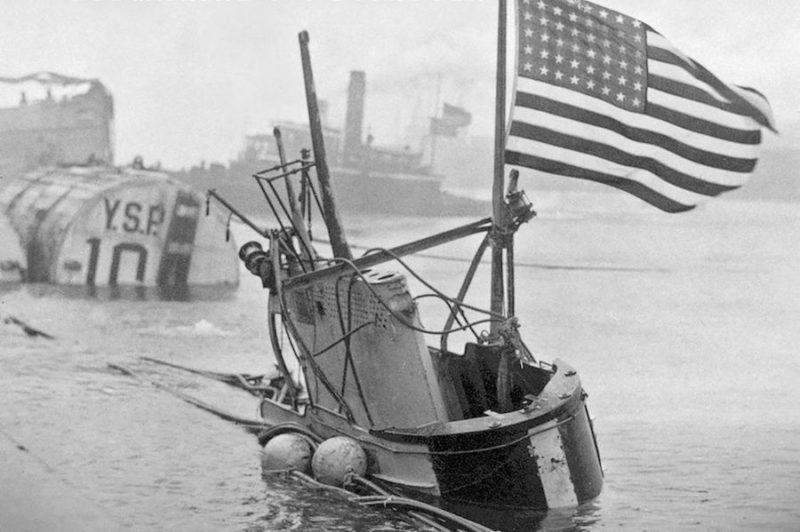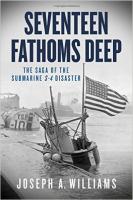Was The World’s ‘Northern-Most Island’ Erased From Charts?
by Kevin Hamilton (University of Hawaii) In 2021, an expedition off the icy northern Greenland coast spotted what appeared to be a previously uncharted island. It was small and gravelly,...






When word was received of the sinking, the Falcon, a minesweeper converted to a rescue and salvage ship, was dispatched from the Navy submarine base at New London, CT. Falcon was the only Navy ship equipped to support divers with the compressors, winches and a decompression chamber. Independently, the best Navy divers and salvage experts were sent to Provincetown from all over the East coast.
Many in the assembled team had worked together before. Two years before, in September of 1925, the submarine S-51 was run down by the merchant steamer City of Rome off Block Island, RI. Only three sailors escaped before the submarine sunk, drowning the remaining 33 crew and officers.
Captain Ernest J. King, salvage expert Edward Ellsberg, and divers Fred Michells, Bill Carr and Tom Eadie had all worked together on the S-51. The S-4, however, was very different. The S-51 was pure salvage. Except for the three survivors, the crew had all died in the collision. In S-4, at least some of the crew might still be alive, although no one knew how many, or for how long.
When the S-4 sank, 6 sailors were trapped in the forward torpedo room and 34 officers and crew were in the after battery and control rooms. As the rising salt water reached the submarine’s batteries, the batteries began to leak deadly chlorine gas. When the divers from Falcon were able to reach the sunken sub, there was no response from the men aft in the battery room. They did, however, hear tapping from the men in the forward torpedo room. Six men were still alive.
The Navy rescuers were not the only group flooding into Provincetown. Newspaper reporters hired fishing boats to take them out to the wreck site, much to the annoyance of the Navy. Two days after the sinking, a prayer was read for the S-4 sailors trapped in the submarine on the floor of the Senate in Washington, DC. The story of the trapped men became national news, reported in lurid headlines by the Washington Post, the New York Times, the Boston Globe and the Hartford Courant, among other papers across the country.
The officers and crew on Falcon in the spotlight were a diverse and fascinating mix of Navy career officers and specialists. Williams’ vivid portrayals of the main characters — diver Thomas Eadie, Captain Ernest King, salvage specialist Edward Ellsberg, and submarine expert Harold “Savvy” Saunders, among others, are particularly well done.
Williams also does a fine job capturing the desperate resolve of the divers and salvors on the Falcon who did all that could be done to save the trapped sailors, pushing the limits of their physical endurance and equipment. The diving gear was massively heavy and the associated lines and hoses were easy to tangle in the twisted wreckage of the submarine in the near darkness one hundred feet down. At one point, the attempt became a rescue within a rescue, as diver Fred Michells became seriously fouled as he was attempting to attach an air hose to the submarine. Chief diver Tom Eadie risked his own life rescuing Michells under incredibly difficult conditions. Eadie was later awarded the Medal of Honor for his heroism.
In the end, however, the rescuers lost their race with time. As they struggled to find ways to get air to the just barely holding on survivors, winter gales made diving impossible. The remaining survivors died in the submarine’s forward torpedo room.
Williams doesn’t end the story with the loss of the men aboard the submarine S-4. Their deaths resulted in a dramatic improvement in submarine safety. Improved emergency communications and signaling gear was installed on all submarines. The Momsen Lung, a personal escape rebreather hood, which had been proposed but shelved before the collision, was put into development and became standard submarine equipment until 1962. Likewise, a rescue diving bell developed after the S-4 tragedy would later save 33 men on the submarine Squalus. Even the hull of the S-4 itself contributed. After being salvaged from the ocean floor and renovated, submarine was used for testing new safety equipment and techniques.
Williams notes the tragic truth that disasters are often the motivation for improvement and change. He writes:
[su_quote]“Theoretically, if these innovations had existed in 1927, the men on the S-4 might have been saved – or their odds of survival might have improved. The men may have used the Momsen Lungs to escape. The submarine would have been found more easily if a locator buoy with a telephone were available, thus saving precious time. Then, if all else failed, a rescue chamber could have been lowered onto the torpedo room to deliver Fitch and his five companions to freedom.[/su_quote]
[su_quote]All of this was theoretically possible within a few years after the S-4 disaster, and none of these inventions would have come to fruition if the collision had not occurred.”[/su_quote]
Joseph A. William’s Seventeen Fathoms Deep: The Saga of the Submarine S-4 Disaster is a gripping account of an important, if forgotten, event in nautical history. Highly recommended.
Join the gCaptain Club for curated content, insider opinions, and vibrant community discussions.


Join the 105,936 members that receive our newsletter.
Have a news tip? Let us know.
Access exclusive insights, engage in vibrant discussions, and gain perspectives from our CEO.
Sign Up




Maritime and offshore news trusted by our 105,936 members delivered daily straight to your inbox.



Essential news coupled with the finest maritime content sourced from across the globe.
Sign Up